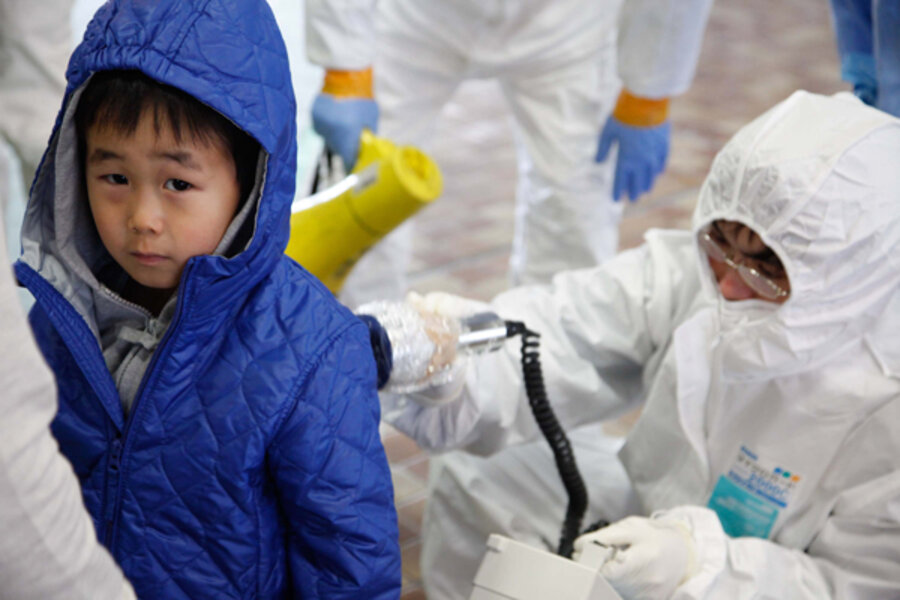Fear of Japan's nuclear crisis far exceeds actual risks, say scientists
Loading...
Fukushima is not Chernobyl, scientists repeat, and even Chernobyl was not as deadly as popularly believed.
Dire warnings of radiation spreading from Japan's embattled Fukushima Daiichi nuclear power plant to deadly effect across Japan, or even to California, are likely overblown, they say.
Radiation is all around us, varying with the number of miles we fly, the elevation of our towns, and the minerals in our environments, scientists point out. We live with it, and most of the time it is harmless.
“There is an increased level of anxiety disproportionate to the actual risk,” says Jerrold Bushberg, who directs programs in health physics at the University of California at Davis. “It’s the dose that makes the poison. It’s not a binary thing.”
Fear and hype surround radiation, which has become something of a bogeyman in part because of popular culture. A radioactive spider bit Peter Parker and turned him into Spiderman. Bruce Banner absorbed radiation in a bomb explosion and became The Incredible Hulk. Radiation from nuclear detonations morphed a small lizard into Godzilla.
“It gives you subliminal messages about the capacity of radiation to do harm,” Professor Bushberg says in a telephone interview.
'Crazy' for Americans to be worried
To be sure, the 1986 nuclear meltdown north of Ukraine’s capital was tragic. Dozens of first-responders died within months from what doctors said was a combination of high radiation, trauma, and burns. It also led to cancer in hundreds of children, says Bushberg, who did environmental studies around Chernobyl in the late 1980s.
But the extent of devastation from Chernobyl is hotly debated.
“After more than 20 years of extensive study, there is no consistent evidence of increased birth defects, leukemia, or most other radiation-related diseases,” journalist Peter Hessler wrote in a 2010 article for The New Yorker. He said the only public epidemic consists of high rates of cancer in children, who tend to be more sensitive to radiation.
Even those incidences of cancer could have been prevented, scientists say, if the Soviet government had warned locals against feeding contaminated milk to their children.
Despite the scale of Chernobyl, none of that radioactivity spread to the United States, according to Bushberg, and it is very unlikely that any significant amount will spread to the US from the unfolding nuclear crisis at the Fukushima Daiichi nuclear power plant (also known as Fukushima I).
A buy-up of potassium iodide tablets, which some say guard against some effects of radiation exposure, is “premature” in America, he says, and concerns over contaminated Japanese exports are also alarmist.
“That’s crazy, absolutely crazy,” agrees Shan Nair, a former nuclear physicist who was one of two UK experts assisting the European Commission in the post-accident Chernobyl response. “It’s important to have a sense of proportion here.”
Chernobyl minor by some standards
“There’s a lack of objectivity sometimes in the responses of people,” he adds. “[The Fukushima crisis] needs to be viewed comparatively with other incidents much more deadly.”
Consider other industrial disasters, such as the 1984 leak of methyl isocyanate at a Union Carbide plan in Bhopal, India that killed some 20,000 people. It is one of many industrial disasters known by doctors to have directly killed thousands of people.
“Chernobyl was bad,” says Bushberg. “[But] in the general category of industrial disasters… no, it wasn’t so bad. Certainly one could quickly find industrial accidents that have resulted in much more serious affects than Chernobyl.”
And even then, Chernobyl was a very different incident from what is now unfolding at Fukushima Daiichi. Chernobyl’s reactor lacked a containment facility, unlike the Fukushima plant, whose GE-made containment vessels have withstood both an earthquake, tsunami, and thus far, a partial meltdown.
“It is blown out of proportion in the US,” says Najmedin Meshkati, University of Southern California, Los Angeles, who has studied both Chernobyl and Japan’s nuclear industry.
“We shouldn’t make a comparison between this one and Chernobyl. Primarily because over there there was no containment vessel, and the reactor exploded. We have partial meltdowns and so far they have been contained,” adds Dr. Meshkati.
Radiation all around
While workers in protective jumpsuits and ominous three-pronged radiation warning symbols flashing across television screens evoke fear, it is important to keep in mind that we are exposed to radiation waves all the time, be it from mobile phones, medical devices, or mere sunlight.
The average American receives 2.95 millisieverts of radiation per year. Meanwhile, the Federal Aviation Administration’s recommended limit (pdf) for an aircrew member is a five-year average effective dose of 20 millisieverts per year, with no more than 50 millisieverts in a single year. According to the National Council on Radiation Protection Measurements, the average airline crew member is exposed to 1.5 times more work-related radiation than the average employee in the nuclear power industry.
And their exposure varies widely depending on their flight routes. Jetting from Seattle to Portland would expose someone to 0.00017 millisieverts. A flight from Athens to New York City would expose you to 0.0613 millisieverts, according to the FAA. None of these doses are harmful, the FAA says, despite popular fears.
When it comes to nuclear power, says Bushberg of the University of California, "there is a lot of misinformation."





